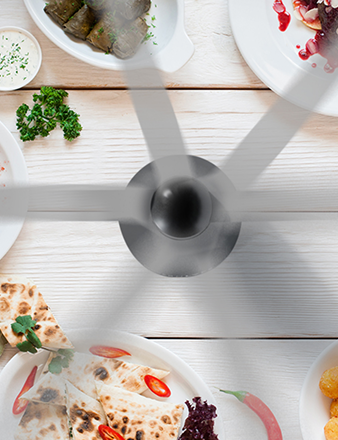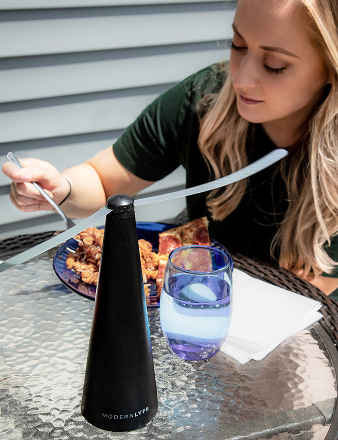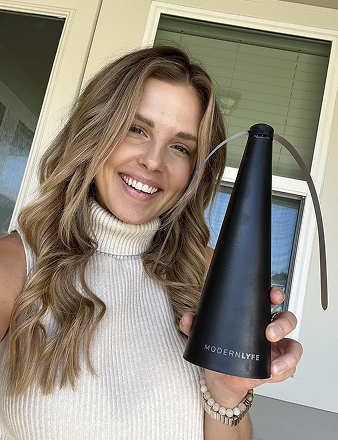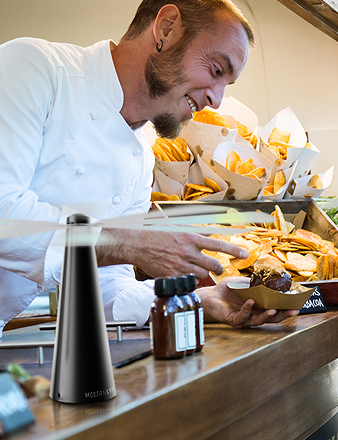That buzzing sound isn't just annoying—it's a problem. Mosquitoes and flies don't just ruin a good time; they carry diseases. Controlling them is about protecting your health, not just your comfort.
This guide gives you the facts and shows you how to stop them for good.
Know Your Enemy
It's easy to lump mosquitoes and flies together as generic pests, but they are driven by completely different needs.
Understanding what makes each one tick is the first step to getting rid of them. They aren't flying around at random; they're following a biological script. The key difference? A mosquito wants your blood. A fly wants your food.
If they're in your home or on your patio, it’s because you have something they need. The secret to effective control is figuring out what that is and taking it away.
Mosquito vs. Fly: The Quick Facts
To solve the problem, you need to see these pests for what they are. They both fly and buzz, but their habits, motivations, and the threats they pose are completely different.
Here's a quick breakdown:
| Characteristic | Mosquito | Fly |
|---|---|---|
| Primary Goal | Blood meal (females) | Food and breeding sites |
| Attraction | Carbon dioxide, body heat, scent | Decaying organic matter, food |
| Key Threat | Transmits diseases (Zika, West Nile) | Spreads bacteria (E. coli, Salmonella) |
| Biting Behavior | Pierces skin to feed on blood | Sponges up food; some species bite |
| Breeding Ground | Stagnant water | Garbage, feces, rotting food |
These differences are critical. A one-size-fits-all approach won't work when their goals are so different.
Different Pests, Different Strategies
Because mosquitoes and flies have different agendas, you need different strategies to stop them.
-
Mosquitoes are hunters. A female mosquito needs blood for her eggs. She can detect the carbon dioxide you exhale from 75 feet away, using it as a homing beacon to find her next meal—you.
-
Flies are scavengers. A common house fly is drawn to filth: garbage cans, animal waste, and rotting food. They aren't targeting you; they just see your home as a buffet and a place to lay eggs.
Bottom line: A mosquito is attracted to you. A fly is attracted to your surroundings. Any effective solution has to address both.
This is a key distinction. Protecting yourself from a mosquito is a different game than securing your environment from a fly. A personal repellent might keep mosquitoes off your skin, but it won’t stop a fly from landing on your potato salad.
This is why tools like chemical-free fly fans from Modern Lyfe work so well. They create a physical air barrier that disrupts the flight paths of both pests, giving you a simple and safe way to enjoy your space.
The Real Danger of Mosquito Bites
We've all been there: enjoying a perfect evening outside, then the sharp prick and infuriating itch of a mosquito bite. It’s easy to dismiss it as a minor annoyance.
But that's a mistake. That tiny insect is one of the most dangerous animals in the world. Think of it as a flying syringe, capable of delivering debilitating—and sometimes fatal—diseases.
This isn't about fear; it's about facts. The real danger of any mosquito and fly problem, especially from mosquitoes, is their role as disease vectors. When a female mosquito bites, she can inject saliva loaded with pathogens directly into your bloodstream. That one bite can start a serious health crisis.
Seeing mosquito control in this light changes everything. It’s not about comfort; it’s about protecting your family.
A Global Health Threat in Your Backyard
Thinking of mosquito-borne diseases as a problem only in faraway countries is a dangerously outdated idea. Global travel and a changing climate are redrawing the map, bringing these illnesses right into our neighborhoods.
Here are a few of the diseases mosquitoes transmit:
- Malaria: A life-threatening parasitic disease affecting millions.
- Dengue Fever: Nicknamed "breakbone fever" for the severe joint and muscle pain it causes.
- Zika Virus: Known for causing severe birth defects and neurological problems.
- West Nile Virus: The most common mosquito-borne illness in the continental United States.
These aren't just names on a list. A West Nile Virus infection can lead to severe neurological diseases like encephalitis or meningitis. A single bite can change your life, which makes prevention a necessity.
The infographic below breaks down the distinct threats from mosquitoes and flies, clarifying why one is a direct health danger and the other is a hygiene nuisance.
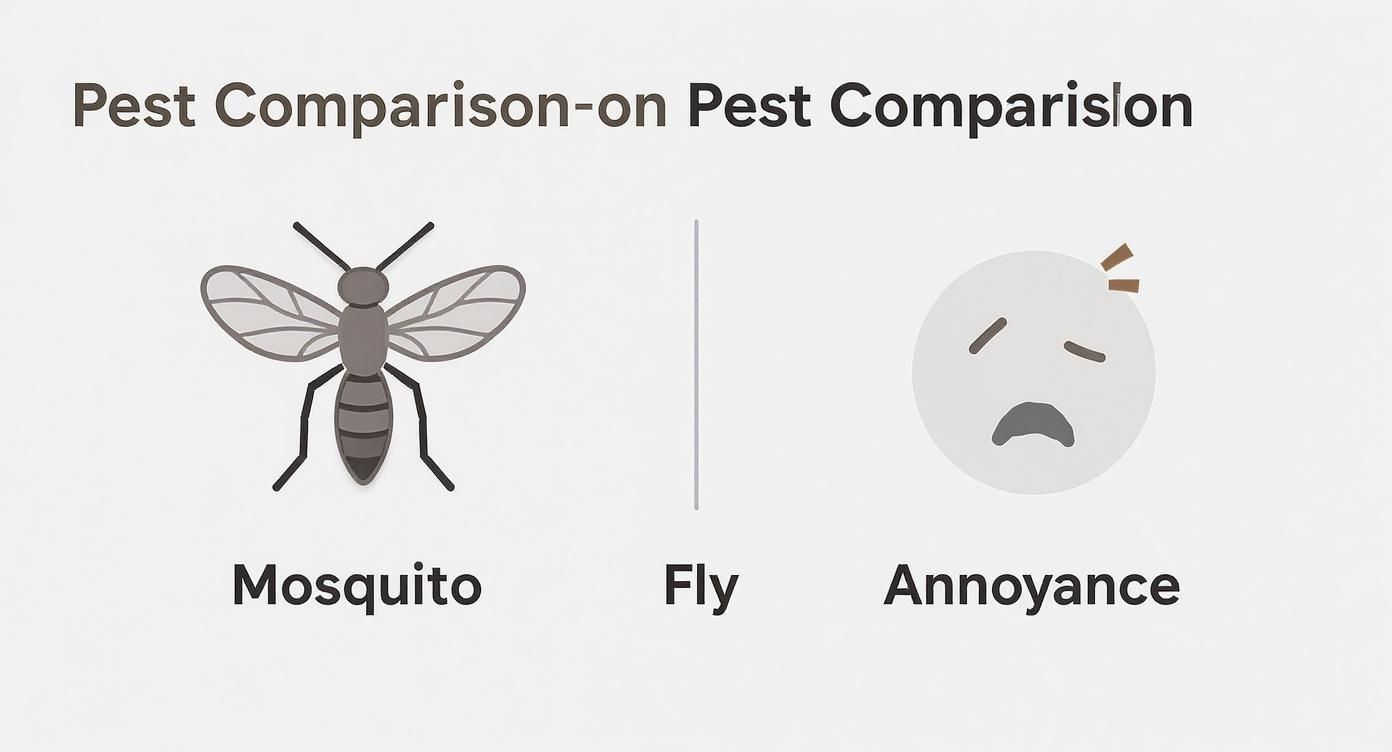
This visual makes the point clear: a mosquito is a direct disease vector, while a fly is a carrier of germs. It’s a crucial distinction that highlights the severity of a mosquito bite.
The Staggering Impact of Mosquito-Borne Illness
The scale of this problem is immense. Every year, mosquitoes infect up to 700 million people and cause more than one million deaths worldwide.
Diseases like malaria, dengue, and Zika create a huge public health burden. To put it in perspective, malaria alone caused an estimated 263 million cases and 597,000 deaths globally in 2023, hitting young children the hardest. You can learn more about this global crisis from the World Mosquito Program.
A mosquito isn’t just looking for a meal; it's potentially transmitting a life-threatening illness. Effective control isn't a luxury—it's essential for your family's health.
That buzzing sound should be more than an annoyance; it should be a reminder of what's at stake. Managing the mosquito and fly population in your space isn't just about peace and quiet. It's about creating a safe zone from the hidden dangers these insects carry.
Why Flies Are a Bigger Problem Than You Think
We’ve all shooed away a persistent fly from our lunch. It feels like a minor nuisance, but that fly is a much bigger problem than you realize. A housefly is a tiny, flying vehicle for germs, and its danger lies in where it was just before it landed on your plate.
Imagine a dirty sponge on wings. A fly spends its day crawling on the grossest things imaginable.
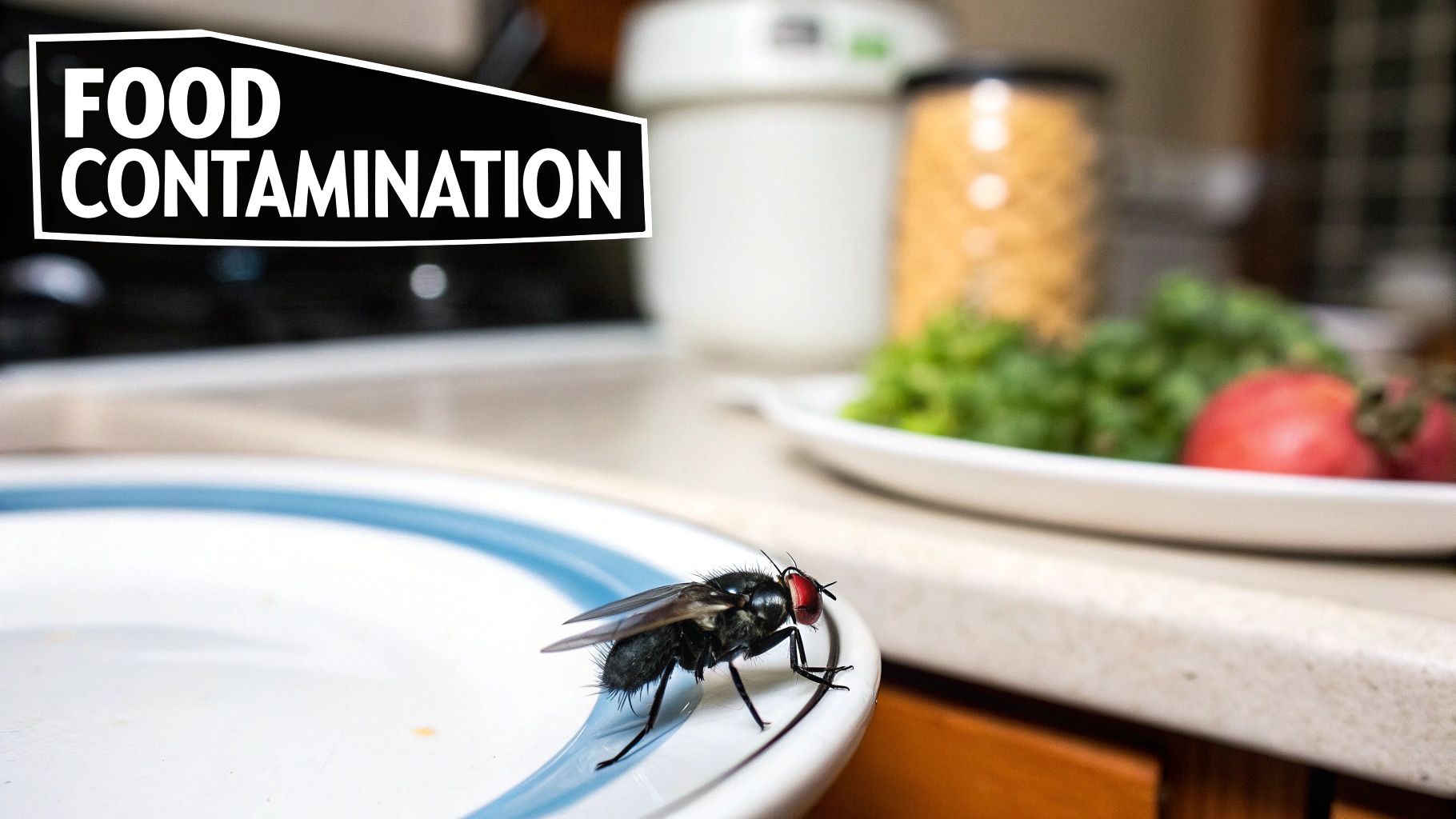
Unlike a mosquito that wants your blood, a fly is a scavenger. Its life cycle revolves around garbage cans, animal waste, and rotting material. As it moves across these surfaces, millions of microorganisms stick to its legs and mouthparts.
Moments later, that same fly lands on your sandwich. This transfer of germs is called mechanical transmission, and it's a direct route for harmful bacteria to contaminate your food, leading to nasty foodborne illnesses.
The Journey from Filth to Food
How a fly eats is even more disturbing. A fly can’t chew solid food, so it vomits a mix of saliva and digestive juices onto your meal to liquefy it before sucking it up.
That "fly spit" is a cocktail of every germ it has collected. This makes flies incredibly efficient at spreading dangerous pathogens.
- Salmonella: A common cause of food poisoning, leading to fever, diarrhea, and stomach cramps.
- E. coli: Certain strains cause severe abdominal pain, bloody diarrhea, and vomiting.
- Shigella: The bacterium behind shigellosis, an infection that causes fever and dysentery.
A single housefly can carry over 100 different pathogens. When it lands on your meal, it’s not just annoying—it's a direct threat to your health.
The risk is even greater where food is left out, like at picnics, barbecues, or restaurant patios. Just one fly can contaminate an entire spread, which is why food safety depends on keeping them away. For more tips, check our guide on how to keep flies away from food.
Ultimately, dealing with a mosquito and fly problem means understanding their different threats. A mosquito is a tiny needle delivering disease directly. A fly is a master of contamination, turning clean surfaces into health hazards.
Why Old Pest Control Methods Fail
When a mosquito or fly appears, what's your first move? Most people grab a can of bug spray, a sticky trap, or a bug zapper. These methods offer a quick fix, but they are temporary solutions with serious drawbacks.
Chemical insecticides have been the go-to for decades. The problem is, aerosol sprays and foggers blanket your space with chemicals, which is a concern for kids and pets. These sprays also kill beneficial insects like honeybees, harming the local ecosystem.
Even after you spray, the relief is short-lived. You might clear the air for an evening, but you haven't stopped the next swarm from arriving tomorrow.
The Trouble with Traps and Zappers
To avoid chemicals, many people turn to physical traps like sticky flypaper. Sure, it catches flies, but then you're left with an unsightly strip of dead bugs hanging in your space.
Then there's the bug zapper. That loud ZAP! sounds effective, but the reality is different. Research shows these devices are terrible at targeting the pests that actually bother us.
Studies have found that less than 1% of the bugs killed by zappers are female mosquitoes—the only ones that bite. They mostly kill harmless, often beneficial, insects.
So while your zapper fries moths and beetles, the real troublemakers ignore it and continue looking for you. Zappers create the illusion of control while failing to solve the problem.
A Smarter Approach to Pest Control
The biggest flaw with these methods is that they're purely reactive. They kill pests that are already present instead of preventing them from showing up in the first place. This endless cycle of "spray and pray" isn't a sustainable solution.
Where Common Pest Controls Go Wrong:
- Chemical Sprays: Pose risks to your family, pets, and the environment for a fix that barely lasts a day.
- Sticky Traps: They're messy, ugly, and do nothing to stop new pests from arriving.
- Bug Zappers: They fail to kill biting mosquitoes and cause collateral damage to the ecosystem.
Real, lasting mosquito and fly control isn't about killing; it's about repelling. The goal is to create a pest-free zone from the start, not rely on flawed, after-the-fact solutions. This shift in mindset leads to safer, smarter, and far more effective ways to enjoy your space.
Use Air Movement for Modern Pest Control
There's a better way to handle pests than swatting and spraying. One of the most powerful and simple strategies involves no chemicals at all: harnessing the power of air movement to create an invisible barrier pests can't cross.
To a tiny mosquito and fly, even a gentle breeze feels like a windstorm. They are weak fliers, and constant airflow makes it nearly impossible for them to navigate, let alone land on you or your food. It’s a simple, physical deterrent that uses their own biology against them.
The breeze also acts as a cloaking device. Mosquitoes track the carbon dioxide (CO2) you exhale and your skin's scent. A steady airflow scatters these signals, making you invisible to them. If they can't smell you, they can't find you.
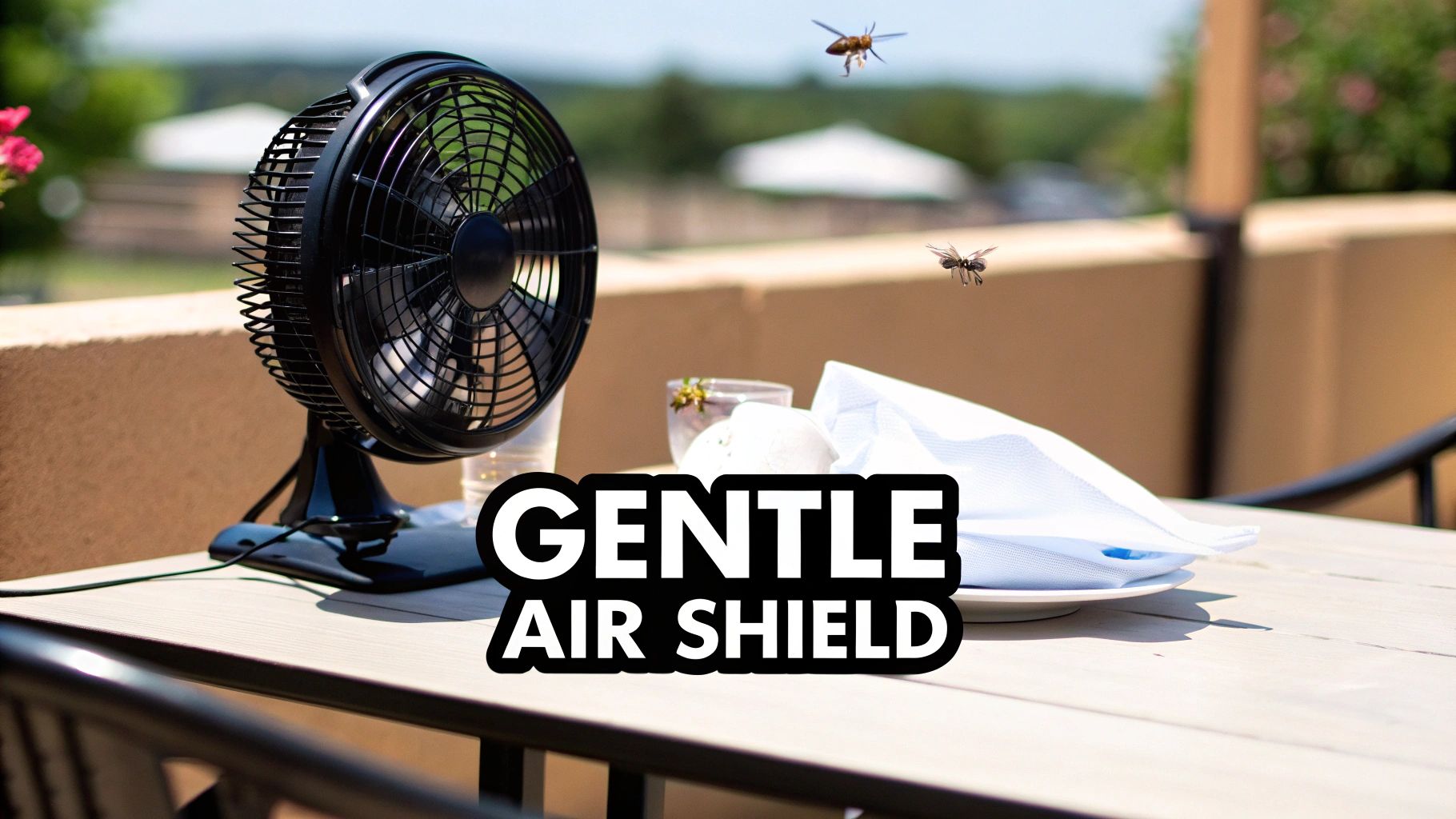
Putting Airflow into Action
This is the science behind Modern Lyfe’s battery-operated fly fans. They turn this simple concept into a sleek, effective, and completely safe tool. Instead of zapping bugs or spraying chemicals, these fans create a gentle vortex of air that disrupts an insect's entire mission.
The concept is simple: if a mosquito or fly can’t land, it can’t bite or contaminate. Air movement becomes a silent, chemical-free guardian for your space.
This method gets to the root of the problem by preventing pests from reaching you in the first place. For a deeper dive into setting up a pest-free zone, check out our guide to using outdoor mosquito fans.
Why Modern Lyfe Fans Are Different
You could point a giant box fan at your patio table, but that’s a clumsy solution that sends napkins flying and forces you to shout over the noise. Modern Lyfe fans are designed for social settings, blending in seamlessly.
They’re built with three key benefits:
- Safe by Design: The fans feature soft, flexible blades with soft-stop technology. If a hand or curious finger touches them, they stop instantly and harmlessly.
- Total Portability: They are battery-operated, so there are no cords to trip over or outlets to find. Place them exactly where you need them: on a picnic blanket, next to a buffet, or on your patio table.
- Enhanced Effectiveness: The blades have a unique holographic pattern that reflects light, which further confuses and repels flies. This combination of air and visual disruption creates a highly effective no-fly zone.
By using the simple power of a breeze, these fans offer a sophisticated and silent way to reclaim your peace. The best fix for a mosquito and fly problem isn't a chemical war—it's creating a space where they simply can't operate.
How to Use Fly Fans for Maximum Effect
A fly fan works, but smart placement makes it unbeatable. Think of each fan as creating a protected bubble of air. Your goal is to arrange these bubbles to form an overlapping, invisible shield over the areas you want to keep free of mosquito and fly invaders.
This isn't about creating a wind tunnel; it's a subtle disruption of the air that makes it impossible for weak fliers to get their bearings. A few well-placed fans create a peaceful, bug-free zone without chemicals, noise, or fuss.
Mastering Fan Placement
The right setup depends on the situation. Whether you're hosting a big BBQ or having a quiet dinner, a few simple rules will deliver the best results.
- For Dining Tables: Use one fan for every two people. On a standard four-person table, place one fan at each end and angle them slightly inward to create a cross-breeze that covers the entire surface.
- Buffet Lines and Food Spreads: Create a defensive line. Place fans every two to three feet along the front of the buffet to form a continuous air curtain that pests can't penetrate.
- Picnics and Outdoor Lounging: Create zones of protection. Circle the food with fans first, then place one or two near your seating area for added comfort.
The idea is to create overlapping fields of air movement. For more setup ideas, our complete guide to using a fly repellent fan has plenty of extra tips.
The best defense is proactive. Set up your fans before the food comes out and before pests even know there's a party. This ensures your protective air shield is running when you need it most.
By thinking ahead, you can set up your defenses in advance. It’s a simple, elegant way to take back your outdoor space and make any get-together more enjoyable.
Got Questions? Let's Talk Mosquito and Fly Control
Even with the best tips, a few questions always come up. Here are answers to some of the most common ones about keeping mosquitoes and flies away.
How can I stop pests from taking over my yard?
Make your yard a terrible place for them to breed.
For mosquitoes, that means eliminating standing water. Check for clogged gutters, old tires, forgotten toys, and saucers under flowerpots. Anything that can hold a capful of water is a potential mosquito nursery.
For flies, cleanliness is key. Ensure your garbage cans have tight-fitting lids. And clean up pet waste immediately, as it’s a major food source and breeding ground for flies.
Play defense. If you make your space inhospitable from the start, you prevent pests from ever getting established.
Are fly fans actually safe for my kids and pets?
Yes, completely. Modern Lyfe fly fans were designed with curious hands and paws in mind.
The blades are soft, flexible, and equipped with soft-stop technology. The moment something touches them—like a child's finger or a dog's nose—they stop instantly without causing harm. It's worry-free protection you don’t get with sprays or zappers.
Can I bring a fly fan inside?
Absolutely. They work just as well indoors.
Set one on your kitchen island while you prep dinner or place it on your dining table to ensure a buzz-free meal. Because they’re battery-powered and whisper-quiet, they provide a silent, invisible shield wherever you need it, with no cords or loud humming.
Ready to reclaim your space and enjoy it without winged intruders? Check out the full lineup of smart, safe solutions from Modern Lyfe.
Find the perfect fly fan to create your own pest-free oasis at the official Modern Lyfe website.

